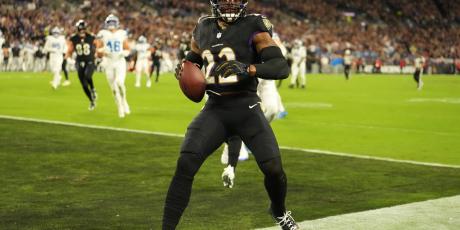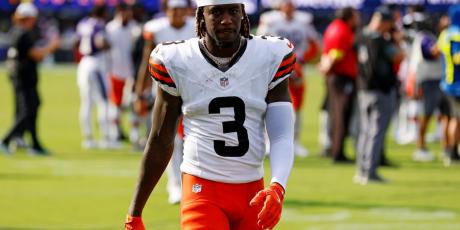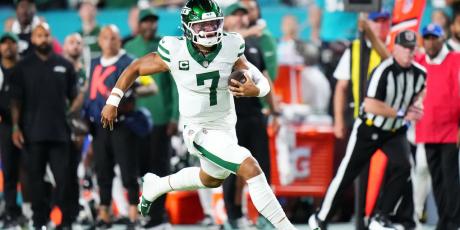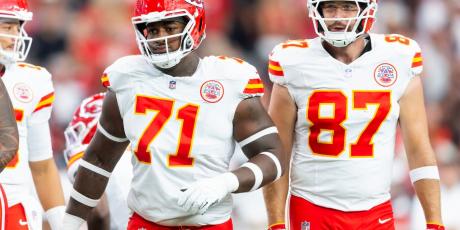The 2014 Rookie Rundown

Note: Be sure to check out the latest episode of the Most Accurate Podcast where John and Anthony Stalter discuss which rookies might make an impact in 2014.
Now that the NFL Draft has finally come and gone, most of the pieces are in place and we can begin to finalize our preseason rankings. 4for4 will release its initial projections by the end of the month, but for now I wanted to present a few thoughts about this year’s crop of rookies and how they might fare in the upcoming season.
First things first, rookies are notoriously disappointing in redraft leagues. For every Doug Martin, there seem to be five Mark Ingrams. In fact, over the past five seasons, a grand total of 21 rookies have offered up starter-caliber numbers (i.e. top 12 for quarterbacks and tight ends, top 24 for running backs and wide receivers). Lets take a look:
QB: Cam Newton (QB4, 2011), Robert Griffin III (QB5, 2012), Andrew Luck (QB8, 2012) and Russell Wilson (QB9, 2012)
RB: Doug Martin (RB2, 2012), Alfred Morris (RB7, 2012), Eddie Lacy (RB7, 2013), Trent Richardson (RB8, 2012), LeVeon Bell (RB15, 2013), Giovani Bernard (RB16, 2013), Knowshon Moreno (RB18, 2009), Zac Stacy (RB18, 2013), Jahvid Best (RB20, 2010) and Roy Helu (RB24, 2011)
WR: Mike Williams (WR11, 2010), A.J. Green (WR14, 2011), Julio Jones (WR17, 2011), Keenan Allen (WR17, 2013) and Torrey Smith (WR23, 2011)
TE: Rob Gronkowski (TE5, 2010), Aaron Hernandez (TE11, 2010)
Of those 21 players, nine were drafted by their teams in the 1st round, five in the 2nd, two in the 3rd, three in the 4th, one each in the 5th and 6th.
An additional 13 (seven running backs and six wide receivers) finished in the #25 to #36 range at their respective positions, making them possible starters in flex formats: Andre Ellington, LeGarrette Blount, Ben Tate, Ryan Mathews, DeMarco Murray, LeSean McCoy and Vick Ballard at RB, and T.Y Hilton, Percy Harvin, Justin Blackmon, Mike Wallace, Hakeem Nicks and Austin Collie at WR.
In that group, four were drafted in the 1st round, two in the 2nd, three in the 3rd, one each in the 4th, 5th and 6th. One player (Blount) went undrafted.
So that’s a total of 34 rookies in five years, or 6.8 starter-quality rookies per year in flex formats. Roughly three-quarters of the players in that group (25 of 34) were drafted in the first three rounds, which makes sense — if a player is drafted early, his new team made a conscientious effort to go and get him, and with that kind of urgency, he probably fills a need. This can sometimes result in fantasy production.
Let’s go position by position and discuss some of the players who figure (or at least have a chance) to produce as rookies.
Quarterbacks
If Josh Gordon weren’t facing a suspension, I’d say that Johnny Manziel would have the best chance to produce solid fantasy numbers. But with Gordon out of the lineup, the Browns are expected to go to a run-heavy offense, and that’s not good for Manziel. So not only will Manziel be missing one of the best receivers in the game, his team is likely to throw the ball less — it’s a double whammy.
So I think Teddy Bridgewater has the best chance to post decent (low- to midrange-QB2) numbers as a rookie. The team has already said that they’d like him to win the job, so we have him penciled in as the starter at this point in the offseason. Norv Turner is a capable play-caller, and Bridgewater will have no shortage of weapons at his disposal in Minnesota. Adrian Peterson will be the focus of the defense, so Bridgewater can pick his spots and deliver the ball to Cordarrelle Patterson, Greg Jennings and Kyle Rudolph.
Blake Bortles is expected to sit, at least early in the season, and his receiving corps in Jacksonville is very green. Derek Carr will likely back up Matt Schaub to start the year, and it’s not like the Oakland QB position is a fantasy goldmine. Tom Savage (in Houston) is the only other QB with a relatively clear path to a starting gig, but Ryan Fitzpatrick is capable of holding him off if the Texans can win a few games early.
At the end of the day, the quarterback position is so deep that there is no reason to burn a pick on a rookie when there are proven veterans like Jay Cutler and Philip Rivers available well into the 10th round.
Running Backs
There is no murkiness here. The running back with the best chance to produce as a rookie was the first one to be drafted: Bishop Sankey of the Titans.
The Titans had a need at the position after they cut Chris Johnson, leaving the team with the underwhelming Shonn Greene and receiving specialist Dexter McCluster atop the depth chart. It turns out that Greene is coming off of knee surgery, which opens the door further for Sankey to seize the starting job. Take a look at some of his highlights from his time at Washington:
Athletically, he tested very well at the Combine, and provided he doesn’t fall flat on his face this summer, he should have the inside track to play the Ryan Mathews role in Ken Whisenhunt’s offense.
How much work can we expect? To find an answer, I compiled a list of the first RB taken in each of the last 20 drafts to see how they did as rookies.
Historical Production of 1st RBs Selected in NFL Draft
| Player | Year | Age | Draft | Tm | G | GS | Rush | Yds | TD | Rec | Yds | TD | FP | Incumbent | Total Yards PY |
|---|---|---|---|---|---|---|---|---|---|---|---|---|---|---|---|
| Knowshon Moreno | 2009 | 22 | 1-12 | DEN | 16 | 9 | 247 | 947 | 7 | 28 | 213 | 2 | 170 | Peyton Hillis* | 522 |
| Warrick Dunn | 1997 | 22 | 1-12 | TB | 16 | 10 | 224 | 978 | 4 | 39 | 462 | 3 | 186 | Errict Rhett* | 550 |
| Reggie Bush | 2006 | 21 | 1-2 | NO | 16 | 8 | 155 | 565 | 6 | 88 | 742 | 2 | 179 | Antowain Smith* | 705 |
| Trent Richardson | 2012 | 21 | 1-3 | CLE | 15 | 15 | 267 | 950 | 11 | 51 | 367 | 1 | 204 | Peyton Hillis* | 717 |
| Ki-Jana Carter | 1996 | 23 | 1-1 | CIN | 16 | 4 | 91 | 264 | 8 | 22 | 169 | 1 | 97 | Harold Green* | 843 |
| Jamal Lewis | 2000 | 21 | 1-5 | BAL | 16 | 13 | 309 | 1364 | 6 | 27 | 296 | 0 | 202 | Errict Rhett* | 1021 |
| Curtis Enis | 1998 | 22 | 1-5 | CHI | 9 | 1 | 133 | 497 | 0 | 6 | 20 | 0 | 52 | Raymont Harris* | 1148 |
| Edgerrin James | 1999 | 21 | 1-4 | IND | 16 | 16 | 369 | 1553 | 13 | 62 | 586 | 4 | 316 | Marshall Faulk* | 2227 |
| William Green | 2002 | 23 | 1-16 | CLE | 16 | 10 | 243 | 887 | 6 | 16 | 113 | 0 | 136 | James Jackson | 610 |
| Ronnie Brown | 2005 | 24 | 1-2 | MIA | 15 | 14 | 207 | 907 | 4 | 32 | 232 | 1 | 144 | Sammy Morris | 647 |
| Mark Ingram | 2011 | 22 | 1-28 | NO | 10 | 4 | 122 | 474 | 5 | 11 | 46 | 0 | 82 | Chris Ivory | 733 |
| LaDainian Tomlinson | 2001 | 22 | 1-5 | SD | 16 | 16 | 339 | 1236 | 10 | 59 | 367 | 0 | 220 | Terrell Fletcher | 739 |
| Marshall Faulk | 1994 | 21 | 1-2 | IND | 16 | 16 | 314 | 1282 | 11 | 52 | 522 | 1 | 252 | Roosevelt Potts | 900 |
| Steven Jackson | 2004 | 21 | 1-24 | STL | 14 | 3 | 134 | 673 | 4 | 19 | 189 | 0 | 110 | Marshall Faulk | 1108 |
| Tyrone Wheatley | 1995 | 23 | 1-17 | NYG | 13 | 1 | 78 | 245 | 3 | 5 | 27 | 0 | 45 | Rodney Hampton | 1178 |
| Darren McFadden | 2008 | 21 | 1-4 | OAK | 13 | 5 | 113 | 499 | 4 | 29 | 285 | 0 | 102 | Justin Fargas | 1197 |
| Giovani Bernard | 2013 | 22 | 2-37 | CIN | 16 | 0 | 170 | 695 | 5 | 56 | 514 | 3 | 169 | BenJarvus Green-Ellis | 1198 |
| C.J. Spiller | 2010 | 23 | 1-9 | BUF | 14 | 1 | 74 | 283 | 0 | 24 | 157 | 1 | 50 | Fred Jackson | 1433 |
| Adrian Peterson | 2007 | 22 | 1-7 | MIN | 14 | 9 | 238 | 1341 | 12 | 19 | 268 | 1 | 239 | Chester Taylor | 1504 |
| Larry Johnson | 2003 | 24 | 1-27 | KC | 6 | 0 | 20 | 85 | 1 | 1 | 2 | 0 | 15 | Priest Holmes | 2287 |
| All | 14.2 | 13.6 | 55.6 | 0.42 | 2.3 | 19.7 | 0.07 | 10.5 | RB17 numbers in 2013 | ||||||
| Following Lackluster/Departed Incumbents | 14.8 | 15.6 | 61.7 | 0.47 | 2.6 | 21.4 | 0.08 | 11.6 | RB12 numbers in 2013 |
* An asterisk indicates a incumbent that left the team prior to the rookie's arrival.
The last seven running backs in the table joined teams that already had an established RB on he roster. I defined "established" as a leading rusher from the previous season who gained at least 1,000 total yards. The only player to see at least 250 touches was Adrian Peterson, who I think we can all agree was a clear upgrade from Chester Taylor. Giovani Bernard had the second-most touches in this group with 226 in a timeshare with BenJarvus Green Ellis.
The other 13 running backs who were drafted first in their RB class took over for lackluster incumbents and/or replaced departed backs. These are the first 13 RBs listed in the table. (The incumbents that left the team have asterisks next to their names, and their total yards gained in the previous year is listed in the "Total Yards PY" column.) This baker’s dozen of rookies averaged 18.2 touches for 83.1 yards and 0.55 TD, or 11.6 fantasy points per game. That’s about what Ryan Mathews averaged as the #12 RB in 2013. With Johnson gone, Sankey falls into this category.
Whisenhunt’s Chargers were extremely balanced from a run/pass standpoint, and with Jake Locker under center, Sankey could see a ton of work. I’d expect his ADP to climb into the 3rd or 4th round by the time August rolls around, perhaps even the 2nd round if it’s clear that he’s going to be the starter in Tennessee.
At this point, no other rookies seem worthy of an early pick. The next seven RBs taken join teams with established starters, with the only exception possibly being Terrance West in Cleveland. The Browns just went out and signed Ben Tate to a hefty contract, and with the aforementioned Josh Gordon suspension, they could go very run-heavy. Still, as a likely backup in what’s projecting to be a lackluster offense, I wouldn’t expect him to hold anything more than late-round value (9th round or later?) on draft day.
Two other backs that went in the first three rounds, the Bengals’ Jeremy Hill and the 49ers’ Carlos Hyde, could earn sizable roles with their new teams if things break their way. Hue Jackson is calling the plays in Cincinnati, and he’s planning to run a run-heavy scheme that will feature Giovani Bernard, but Hill could take over for BenJarvus Green-Ellis if he has a good summer. Hyde’s role in San Francisco is a bit murkier. Frank Gore is no spring chicken, but always seems to hold off the competition, and Marcus Lattimore is waiting in the wings. This is a committee to monitor.
One other thing to note — after signing Toby Gerhart and Rashad Jennings in free agency, the Jaguars and Giants didn’t make a big splash in the draft at the position. Jacksonville waited until the 7th round to pick up a RB (Storm Johnson), while the G-Men used a 4th on Andre Williams. At this point, I’m more worried about Williams stealing work from Jennings, but HC Tom Coughlin generally does not like to depend on rookies.
Wide Receivers
Remember that earlier stat — just five rookie wideouts have finished in the top 24 in the last five years, and six more finished in the #25-#36 range, so that’s an average of 2.2 per year that were startable in flex formats. Just two of the 11 were drafted outside the first three rounds. Rookie wideouts are not a good place to mine for value, though there are usually a couple of youngsters who make their mark each year.
The first wide receiver to be drafted this year was Sammy Watkins with the #4 overall pick. He’s not landing in a good situation, since the Bills are run-heavy and E.J. Manuel is his quarterback. But with Stevie Johnson out of the way, the potential is there for solid production. The same goes for Mike Evans, who will play second fiddle to Vincent Jackson in Tampa Bay. Both players look like fantasy WR3 types, though Watkins has some upside if he sees real-world WR1 targets (~139).
After Watkins and Evans, there aren’t any shoo-in starters, though there are several players who seem destined for big roles in 2014. Kelvin Benjamin figures to play right away for the Panthers even though he’s something of a project. At 6’5”, he should be a factor in the red zone at least. Odell Beckham went with the 1.12 pick, which means the Giants are likely to use him, though it’s not clear how he’ll fit in the pecking order with Victor Cruz, Rueben Randle (who is the biggest of the bunch) and Jerrel Jernigan. I’d have to assume that Beckham will be at worst the Giants’ WR3 and could relegate Randle to that role.
The Saints used the 1.20 pick on Brandin Cooks, which sparked this interesting discussion on Twitter. New Orleans has to replace both Lance Moore and Darren Sproles, who combined to get 143 targets in 2013. Even if Kenny Stills sees the same workload as Moore did the previous three seasons (5.5 T/G or 88 targets on the season, up from 50 in 2013), that still leaves 105 targets to be distributed among the other players on the roster. It’s telling that the team used a first round pick on Cooks since it shows intent. In the aforementioned Twitter conversation, Matthew Berry made a good point about how the Saints like to spread it around, but they’re not bringing in Cooks to replace Moore or Sproles — each player leaves a sizable hole in the offense, and I think there’s enough targets to go around provided Cooks has a good offseason and the team is willing to use him in the Sproles role.
Marqise Lee and Allen Robinson were drafted to shore up a Jacksonville receiving corps that isn’t expecting to have Justin Blackmon (suspension) available in 2014. Cecil Shorts figures to start if healthy, so the question is — which rookie will get starter’s snaps on the other side? This is a camp battle to monitor this summer.
Jordan Matthews has a great size/speed combo that should be a good fit for Chip Kelly’s offense. DeSean Jackson is gone and Matthews’ main competition for targets consists of Jeremy Maclin (coming off of a knee injury), Riley Cooper and TE Zach Ertz. Kelly said that Matthews will start off in the slot, which is interesting because that’s the role that Ertz was rumored to be taking.
The four other 2nd round picks — Seattle’s Paul Richardson, Green Bay’s Davante Adams, Denver’s Cody Latimer and Miami’s Jarvis Landry — are all joining receiving corps with multiple established vets. They are worth monitoring, but at this point no one in this group seems destined for real-world WR2 targets (~88) in 2014.
Three wideouts — Philadelphia’s Josh Huff, Indianapolis’ Donte Moncrief and Arizona’s John Brown — went in the third round. Again, these players are unlikely to see starter’s snaps barring a surprise camp battle or injury.
I’d normally stop here, but there are a few 4th round wideouts worth monitoring this summer due to good opportunity. The Jets’ Jalen Saunders and Shaquelle Evans join a receiving corps that added Eric Decker but is still looking for talent. It’s unlikely that either will beat out the steady Jeremy Kerley, but it’s worth a look.
The Steelers drafted Martavis Bryant, who has 1st round measurables (6’4”, 4.42 speed), but lacks consistent hands. He’ll reportedly have a chance to win the starting job opposite Antonio Brown with Markus Wheaton and the newly signed Lance Moore as his primary competition.
Finally, the Chiefs added slot receiver DeAnthony Thomas, who figures to replace Dexter McCluster in Andy Reid’s offense. The team is not exactly loaded at receiver — Dwayne Bowe, Donnie Avery, anyone? — so there is room for Thomas if he can make plays.
Tight Ends
Rookie tight ends don’t often make much of an impact. In the last five seasons only Rob Gronkowski and Aaron Hernandez finished with starter-caliber numbers and they did it in the same year with the same team.
This list of the 21 rookie 1st round picks isn’t encouraging, either. Only two players — Jeremy Shockey (TE3, 2002) and Heath Miller (TE11, 2005) — finished with starter-caliber numbers as rookies.
There are a few players to keep an eye on, however. Eric Ebron went 1.10 to the Lions, and although Brandon Pettigrew and Joseph Fauria are still around, Ebron has the talent to contribute right away if he can get on the field. He said that the Lions plan to use him in the Jimmy Graham role in Joe Lombardi’s offense — Lombardi came from New Orleans — but we’ll see if that actually pans out in his first season. (Doubtful.) With Calvin Johnson, Golden Tate, Reggie Bush and Joique Bell in the mix, targets will be at a premium in Detroit.
Two other tight ends jump out as candidates to play immediately: Austin Seferian-Jenkins and Jace Amaro. Both players went in the 2nd round (to the Buccaneers and Jets, respectively), and neither player has strong competition at the position. Tampa Bay signed Brandon Myers and Tim Wright seems to be on the outs, so if Seferian-Jenkins has a strong summer, he could be starting Week 1. Meanwhile, Amaro has Jeff Cumberland to contend with in New York. Cumberland is underrated, but Amaro has better receiving skills.
Lastly, the Packers took Richard Rodgers in the 3rd round. He’s not a polished, ready-to-play tight end, but he’s a good receiver and the Packers seem to value good hands more than good blocking. The team also likes the athletic Brandon Bostick, and Andrew Quarless is back after filling in admirably for an injured Jermichael Finley last season.
None of these rookies project to be a fantasy starter, but they could all be in the mix as TE2/streamable-types by midseason.
Bottom Line
Here’s my advice for 2014: In redraft leagues, don’t fall in love with any rookies not named Bishop Sankey. There are several players worth monitoring and possibly targeting in the middle or later (i.e. 8th-12th) rounds of fantasy drafts, but the evidence has to be compelling to convince me to pull a trigger on a rookie.






















